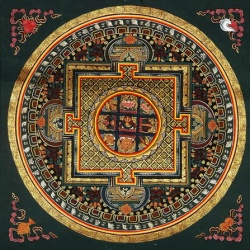Mandala with Symbols of Guhyasamaja Akshobhyavajra
This is a rare, symbol mandala (here the deities are represented by symbolical implements) used for secret initiation in the protective practice of Guhyasamaja Akshobhyavajra, a part of Vajrayana.
Vajrayana Buddhism is one of the most complexes of all metaphysical system known to man.
It refers to Shunyata which is designated a vajra because it is firm and sound and cannot be changed, penetrated, pierced, and burnt.
Thus it is the adamantine path or vehicle.
It introduced the methodology that enlightenment can be obtained in a single lifetime through the direction of the guru and intense arduous practice which involves yogic transformative meditation and visualizations to realize the enlightenment state.
Vajrayana also introduced the theory of the five Dhyani Buddhas from which deities emerged.
Moreover it introduced the worship of the Prajna (Shakti) in Buddhism and a host of the other things including a large number of gods and goddesses their sadhana for the purpose of visualization, mantra, tantra, Yantra, mudra, implements, ritual and mandala etc.
The centre point of the mandala depicts the image of the deity some times it is represented by his or her symbols.
The inner circle of present thangka portrays the attributes of Guhyasamaja Akshobhyavajra.
Guhyasamaja's name means secret union or assembly of the secret ones.
Guhyasamaja is associated with the Buddha Akshobhya.
The Guhyasamaja Tantra itself calls him Akshobhyavajra.
In Tibet, he is particularly favoured by the Gelukpa Order.
The centre of the mandala depicts Vajra-Chopper (Vajra-topped Chopper), generally symbolizes method and wisdom, and is held by Dakinis, Yamantaka, Mahakala and so on.
The Chopper of Dakinis symbolizes the cutting of all negative forces, as the wisdom consciousness that terrifies all maras or emotional defilements and serves all conceptualizations.
Moreover it cuts through the six hindrances to meditative contemplation;
pride,
lack of belief,
lack of devotion,
distraction,
in-attention and
boredom.
Here it symbolizes union of male and female principle (method and wisdom).
The Vajra-Chopper is surrounded with the symbol of Akshobhyavajra generally held by him and his consorts the Vajra,
which symbolizes Buddha clan of Akshobhya,
the Lotus, the discriminating wisdom clan of Amitabha,
the Wheel symbolizes the mirror wisdom clan of Vairochana,
the jewel symbolizes the equality wisdom clan of Ratnasambhava, and
the sword, the all-accomplishing wisdom clan of Amoghasiddhi.
Thus Guhyasamaja Buddha symbolically represents the union of all the Buddha clans.
The inner circle of the mandala is surrounded by the circle of mount meru and the area outside this circle is filled with floral motifs.
The building has four-gateways guarded by protective deities; syllable mantra is depicted in each gateways.
Over the four gateways are buildings in which live the celestial deities.
There are two victory banners each side of the gateways.
The area outside the gateways is filled with flowers.
The square is surrounded by four circles.
The outer circle is of fire fence, which is florally rendered here.
Then there is a circle of syllable mantra.
Thereafter is the circle of lotus petals.
The four corners of the painting are filled auspicious symbols, lotus, conch, wheel and cymbals.
Ben Meulenbeld, Buddhist Symbolism in Tibetan Thangka, Holland, 2001
J.C. Huntington and D. Bangdel, The Circle of Bliss: Buddhist Meditational Art, Ohio, 2004
Lokesh Chandra, Transcendental Art of Tibet, Delhi, 1996
Robert Beer, The Encyclopedia of Tibetan Symbols and Motifs, Boston, 1999
This description is by Dr. Shailendra K. Verma, whose Doctorate thesis is on "Emergence and Evolution of the Buddha Image (From its inception to 8th century A.D.)".
